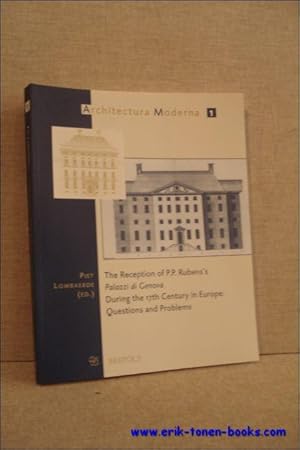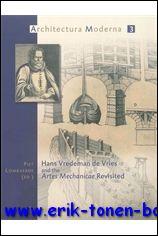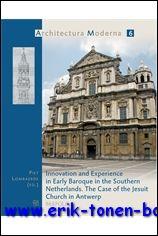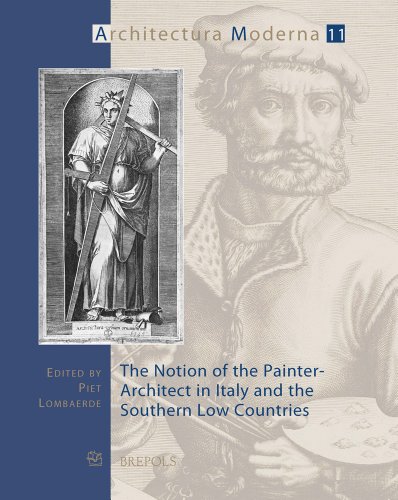P LOMBAERDE ED ; (6 risultati)
Tipo di articolo
- Tutti gli articoli
- Libri (6)
- Riviste e Giornali
- Fumetti
- Spartiti
- Arte, Stampe e Poster
- Fotografie
- Mappe
-
Manoscritti e
Collezionismo cartaceo
Condizioni
Legatura
Ulteriori caratteristiche
- Prima edizione (1)
- Copia autografata
- Sovraccoperta (2)
- Con foto (4)
- No print on demand
Paese del venditore
Valutazione venditore
-
HANS VREDEMAN DE VRIES AND THE "ARTES MECHANICAE" REVISITED
Editore: BREPOLS, 2005
ISBN 10: 2503518133ISBN 13: 9782503518138
Da: Pórtico [Portico], ZARAGOZA, Spagna
Libro
Encuadernación de tapa blanda. Condizione: Nuevo. LOMBAERDE, P., ED.: HANS VREDEMAN DE VRIES AND THE "ARTES MECHANICAE" REVISITED. TURNHOUT, 2005, xii 260 p. figuras, 1024 gr. Encuadernacion original. Nuevo. (TB-1-4) 1024 gr. Libro.
-
Reception of P.P. Rubens's Palazzi di Genova during the 17th Century in Europe: Questions and Problems,
Editore: Turnhout Brepols 2012, 2012
Da: BOOKSELLER - ERIK TONEN BOOKS, Antwerpen, Belgio
Membro dell'associazione: ILAB
Paperback, 262 p., 200 b/w ill., 220 x 280 mm. ISBN 9782503513010. Rubens book Palazzi di Genova' was well diffused in European countries as England, the Netherlands, France, Germany and Italy thanks to the numerous contacts the famous painter and diplomat maintained in humanistic, artistic and political circles. From 1622 on this book, containing two volumes, was edited at several times during the 17th and 18th Century. But the direct influences of the numerous facades, plans, cross-sections, staircases and building details on modern architecture look rather limited, especially in his own country. In this study, several scholars in architectural history analyse how the examples of Genoese palazzi and churches as presented by Rubens were accepted in different European countries. Much attention is given to the question if these examples inspired a new architectural typology, in which the inner court of the houses was substituted by a 'salone in mezzo'. An attempt is made to situate Rubens' book among the late 16th and early 17th Century treatises and model books. The way in which Rubens presented the new Genoese architecture of villa's, palaces and churches and the introduction he wrote as a 'painter-architect' to this book were so modern at that time, that the reception of this prestigious edition in folio had more to do with changes in considering architectural theory and practice as with the propagation of a late renaissance style influenced by Antique examples. Languages: English, French, German. New.condition !! 0 g.
-
Innovation And Experience In Early Baroque In The Southern Netherlands. The Case Of The Jesuit Church In Antwerp.
Editore: Turnhout Brepols 2008, 2008
Da: BOOKSELLER - ERIK TONEN BOOKS, Antwerpen, Belgio
Membro dell'associazione: ILAB
Paperback, original editor's jacket, english, 22x28 cm., 266 pp., 186 b/w + 16 colour illustrations. ISBN 9782503523880. Architectura Moderna ARCHMOD 6. It is the aim of this publication to bring together researchers to confront the results of their studies about the interpretation of the facade of this Counter-Reformation church, the phenomenon of diffuse light created by reflection and refraction on marble statues, pillars and multiple ornaments, the combination of linear and parallel perspective applications, the sacral and social use of space, the signification of the facade and towers as parts of a perspective scene in the city landscape and the relationship of Rubens's paintings with the Baroque interior. Special attention is also devoted to the School of Mathematics, installed in Antwerp by the Jesuits at that time. 0 g.
-
Hans Vredeman De Vries And The Artes Mechanicae Revisited ,
Editore: Turnhout Brepols 2005, 2005
Da: BOOKSELLER - ERIK TONEN BOOKS, Antwerpen, Belgio
Membro dell'associazione: ILAB
Paperback, XII+261 pages ., 157 b/w ill., 220 x 280 mm. ISBN 9782503518138. In this publication, attention is devoted to the technical aspects in the work of Hans Vredeman de Vries. Throughout his long career, he has perfected his skills as a painter, architect, fortification engineer and hydraulic engineer. Those technical aspects are considered not so much as discrete characteristics, but rather as a particular way in which this late sixteenth- century artist from the Low Countries typically dealt with a number of disciplines of the technical and applied arts. Indeed, from a predominantly traditional approach to his work, too much emphasis has until now been placed on his highly personal contribution to the dissemination of ornamental elements, whereby typical Renaissance characteristics, such as technical innovation and engineering, are relegated to the background. During Hans Vredeman de Vries's lifetime, attempts began to be made to define the arts and the sciences. Defining the demarcation criteria of the sciences would continue to gain in importance especially at the beginning of the seventeenth century. With his work, Vredeman de Vries raised Architectura together with all its technical acquisitions to the level of both the Artes and the Scienciae. Attempts were even made to establish some kind of hierarchy. Yet the artist never strictly separated fine and applied arts, nor did he explicitly distinguish between theory and practice. It was the intention of Vredeman de Vries to aim towards an equilibrium between the sciences and the arts. A team of thirteen distinguished art and architectural historians from North America, Germany, the Netherlands and Belgium focus upon Vredeman de Vries's diverse manifestations of knowledge: urbanism, fortification works, hydraulics, interior decoration, architecture (its practical and technical aspects), inlay work and furniture, tapestry and the use of scientific instruments. One author points out that the similarity between such 'technical' practices and the structure of, for example, sixteenth-century rhetorical practices, forces us to consider Vredeman de Vries not simply as an architect, an engineer, or a designer, but above all as an experimenter in multiple disciplines and various fields. New. 0 g.
-
Innovation and Experience in Early Baroque in the Southern Netherlands. The Case of the Jesuit Church in Antwerp,
Editore: Turnhout Brepols 2008, 2008
Da: BOOKSELLER - ERIK TONEN BOOKS, Antwerpen, Belgio
Membro dell'associazione: ILAB
Paperback, 266 p., 186 b/w ill. + 16 colour ill., 220 x 280 mm. ISBN 9782503523880. During the sixteenth century Antwerp was at the forefront of the Renaissance north of the Alps. Not only a new architectural style flourished in the Antwerp metropolis, but at the end of the sixteenth century sciences such as mathematics, optics, geometry and perspective became more and more important. They helped to redefine architecture and the other fine arts on a more scientific base. Their introduction in the arts at the beginning of the seventeenth century lead to new experiences, applications and even innovations in architecture. The Jesuit Order played a very crucial rule in this process. The realization of their new church in the centre of the city of Antwerp became one of the first attempts to bring together the applications of all those new ideas in one total project. Paintings by Peter Paul Rubens and sculptures by Hieronymus Duquenoy, Artus Quellinus etc. were participating in one of the first Early Baroque architectural realizations in the Low Countries. The Jesuit Church of Antwerp, actually the St Carolus Borromeus Church, was designed by Francois d'Aguilon, a scientist and architect of the Jesuit Order. His publication Opticorum Libri sex on optics and on the reflection of light was edited by the Officina Plantiniana in 1613, the same year he started his project for the church. This scientific and theoretical work helps us to understand the new experiences with light and space he experimented with. It is the aim of this publication to bring together researchers to confront the results of their studies about the interpretation of the facade of this Counter-Reformation church, the phenomenon of diffuse light created by reflection and refraction on marble statues, pillars and multiple ornaments, the combination of linear and parallel perspective applications, the sacral and social use of space, the signification of the facade and towers as parts of a perspective scene in the city landscape and the relationship of Rubens's paintings with the Baroque interior. Special attention is also devoted to the School of Mathematics, installed in Antwerp by the Jesuits at that time. The central question will be whether we can conclude that at the beginning of the seventeenth century the innovative sense of creating a new architecture, so typical for the sixteenth century in Antwerp, still persisted in this city during the early seventeenth century, and even lead to a new interpretation of architectural space in European context. New. 0 g.
-
The Notion of the Painter-Architect in Italy and the Southern Low Countries
Editore: Brepols Publishers, Turnhout, 2014
ISBN 10: 2503548504ISBN 13: 9782503548500
Da: Luigi De Bei, PREGANZIOL, TV, Italia
Libro Prima edizione
Couverture souple. Condizione: Neuf. Condizione sovraccoperta: Neuf. Edition originale. Architectura Moderna(ARCHMOD 11) The Notion of the Painter-Architect in Italy and the Southern Low Countries P. Lombaerde (ed.) XXIV+311 p., 258 b/w ill., 220 x 280 mm, 2014 ISBN: 978-2-503-54850-0 Languages: English Paperback The publication is available. Retail price: EUR 125,00 Since the time of Vitruvius, architects have been expected to have a broad knowledge of the arts and sciences. The need for good skills in sketching and working up drawings even led, from the sixteenth century onwards, to fierce debates on the meaning and status of 'disegno'. While Italy saw the emergence of famous painters who excelled as architects, also in the Southern Netherlands the notion that an architect must also have a mastery of the painter's art became widespread, owing in part to the dissemination of publications by Sebastiano Serlio and Pieter Coecke van Aelst. In the seventeenth century, Peter Paul Rubens was able to make his own contribution to this discussion as a consequence of his sojourns in Italy (1601-1608). Bringing together distinguished art and architecture historians from Europe and North America, this interdisciplinary approach will shed light on the interrelationship of architecture and painting in the Southern Netherlands. Piet Lombaerde is professor in theory and history of architecture and urbanism at the University of Antwerp, faculty of design sciences. His research interests cover the history of fortifications (1500-1900), urban history and the history of hydraulics. He is co-editor with Krista De Jonge (KU Leuven) of the series Architectura Moderna (Brepols Publisher) and author of several books on the history and theory of architecture and urban planning. ? Size: 220 x 280 Mm.







